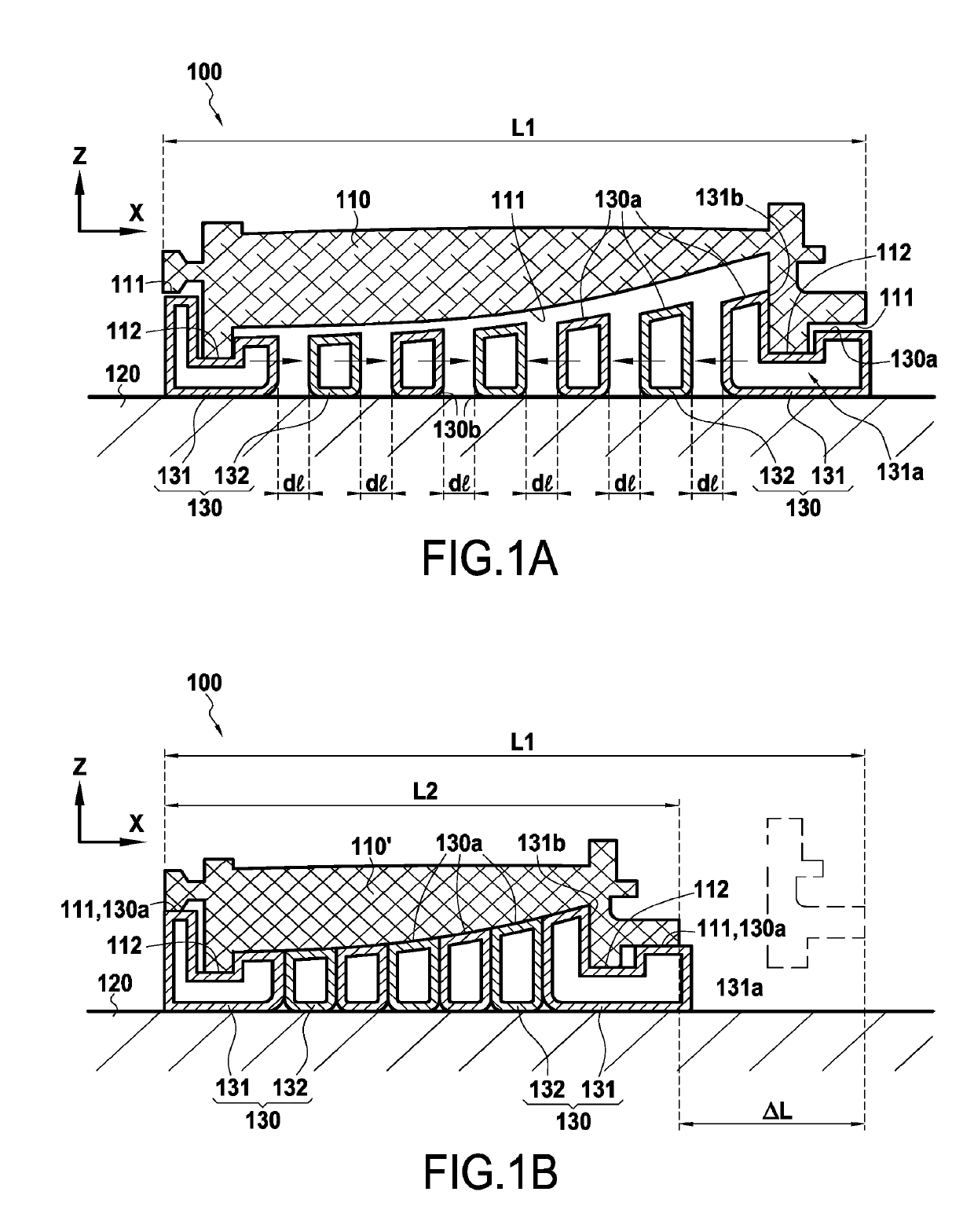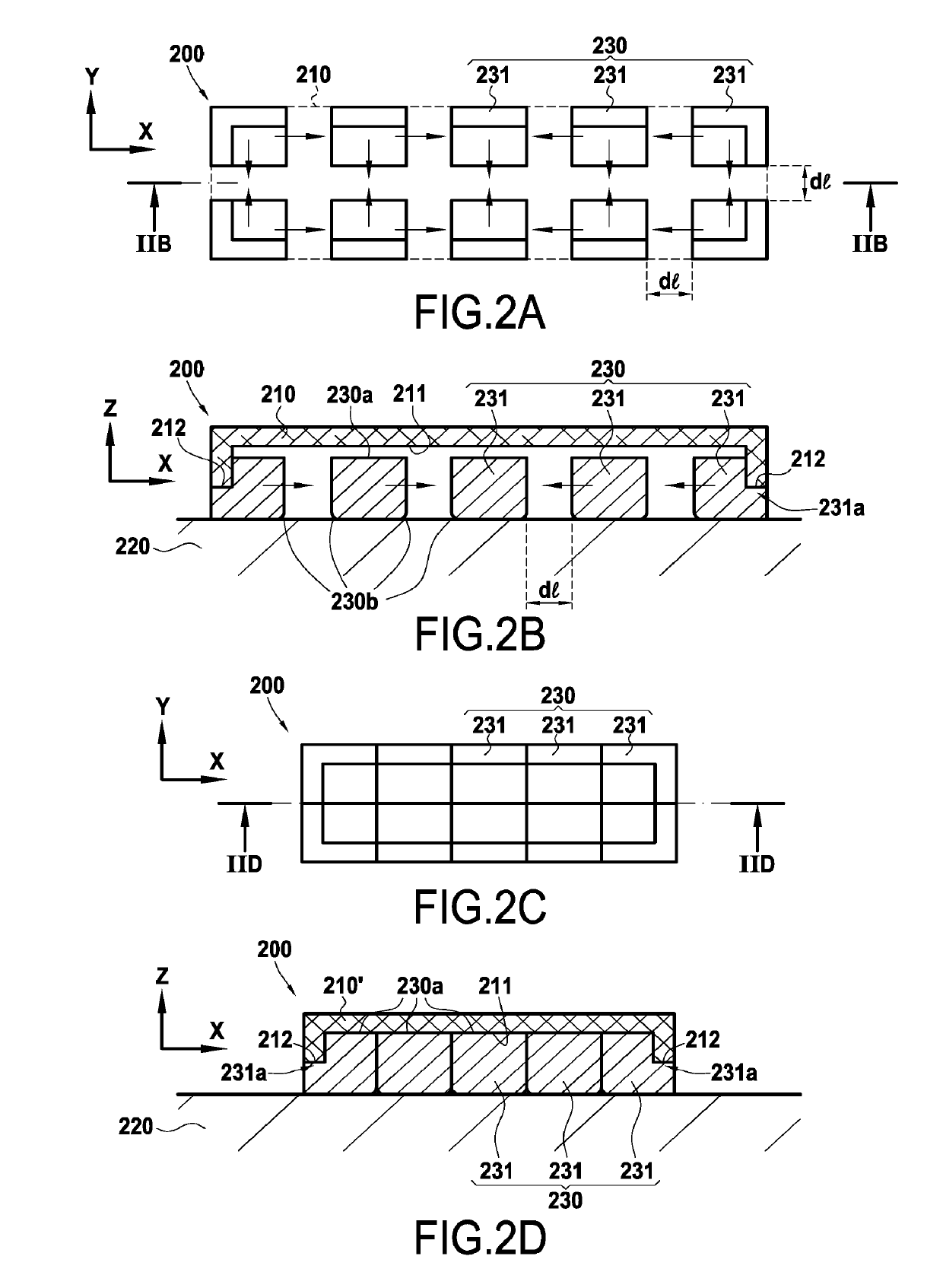Tooling for use during heat treatment to support a preform made of powder
a technology of heat treatment and support, which is applied in the field of applying heat treatment to preforms, can solve the problems of increasing the quantity of powder needed, the cost, and the time for fabricating each part, and achieves the effect of shrinkage amplitude and speed
- Summary
- Abstract
- Description
- Claims
- Application Information
AI Technical Summary
Benefits of technology
Problems solved by technology
Method used
Image
Examples
first embodiment
[0041]FIGS. 1A and 1B show tooling 100 of the invention in a substantially one-dimensional configuration. The arrangement of the tooling 100 shown in FIG. 1A is that adopted prior to the sintering step beginning, whereas the configuration of FIG. 1B is that obtained after sintering has been performed.
[0042]FIG. 1A shows tooling 100 of the invention for supporting a vane preform 110. Once it has been sintered (FIG. 1B), the vane 110′ may constitute a guide vane for an aviation turbine engine. In this example, the vane preform 110 has a plurality of suspended surfaces 111 that are suspended relative to two bearing surfaces 112 and presents a total length L1 in its longitudinal direction (along a horizontal axis X), the length L1 of the preform 110 being much greater than its width.
[0043]The vane preform 110 is previously made by a known technique of shaping powder. By way of example, mention may be made of the powder injection molding method that consists in preparing a composition co...
second embodiment
[0062]FIGS. 2A to 2D show tooling 200 of the invention in a two-dimensional configuration with a shape of rectangular type.
[0063]FIGS. 2A and 2B are respectively a plan view and a longitudinal section view on plane IIB of the tooling 200 before the sintering step. The tooling 200 is for supporting a preform 210 of rectangular shape that presents a suspended surface 211 extending longitudinally along an axis X and transversely along an axis Y. In accordance with the invention, the tooling 200 comprises a tray 220 surmounted by a set of blocks 230 made up in this example of two rows of outer blocks 231 that support the preform via its bearing surfaces 212, these surfaces 212 being in contact with steps 231a positioned in the blocks 231 (the steps 231a have the same function as the grooves 131a of the tooling 100).
[0064]With this shape, the preform needs to be held in the longitudinal and transverse directions in order to avoid suffering creep, which explains the use of the set of bloc...
third embodiment
[0068]FIGS. 3A to 3D show tooling 300 of the invention in a two-dimensional configuration with a shape of cylindrical type (or indeed a body of revolution).
[0069]FIGS. 3A and 3B are respectively a plan view and a longitudinal section view on plane IIIB of the tooling 300 before the sintering step. The tooling 300 is to support a preform 310 in the form of a ring and presenting a cantilevered-out surface 311 at its periphery. In accordance with the invention, the tooling 300 comprises a tray 320 surmounted by a set of blocks 330 made up in this example of outer blocks 331 in the form of sectors supporting the preform via bearing surfaces 312 thereof, the bearing surfaces 312 being received in grooves 331a formed in the blocks 331.
[0070]In this example, the cantilevered-out surface 311 of the preform 310 slopes a little and is situated on the outside (relative to the center of the ring) of the bearing surface 312. Thus, the surfaces 330a of the blocks 331 for supporting the preform sl...
PUM
| Property | Measurement | Unit |
|---|---|---|
| shrinkage | aaaaa | aaaaa |
| angle | aaaaa | aaaaa |
| thickness | aaaaa | aaaaa |
Abstract
Description
Claims
Application Information
 Login to View More
Login to View More - R&D
- Intellectual Property
- Life Sciences
- Materials
- Tech Scout
- Unparalleled Data Quality
- Higher Quality Content
- 60% Fewer Hallucinations
Browse by: Latest US Patents, China's latest patents, Technical Efficacy Thesaurus, Application Domain, Technology Topic, Popular Technical Reports.
© 2025 PatSnap. All rights reserved.Legal|Privacy policy|Modern Slavery Act Transparency Statement|Sitemap|About US| Contact US: help@patsnap.com



